Dell U2412M - 16:10 IPS without Breaking the Bank
by Chris Heinonen on February 28, 2012 9:00 AM ESTDell U2412M Color Uniformity and Gamut
Of course if only the center of the panel looks good, it’s going to make images look bad with color shifting and other undesirable results. Taking a set of nine measurements around the screen lets us evaluate the screen uniformity.
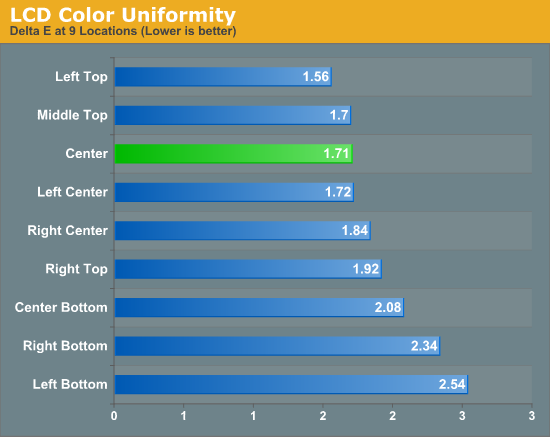
There is a bit of a shift around the screen that is most noticeable in the corners and with the grayscale. The average dE for all the measurements manages to stay below 3, but all the blue swatches stay above 3 across the display. At a couple locations certain colors manage to rise above 3, but for the most part it is just blue. The rise in the grayscale is the most noticeable thing, which is what causes the high average dE results in the corners.
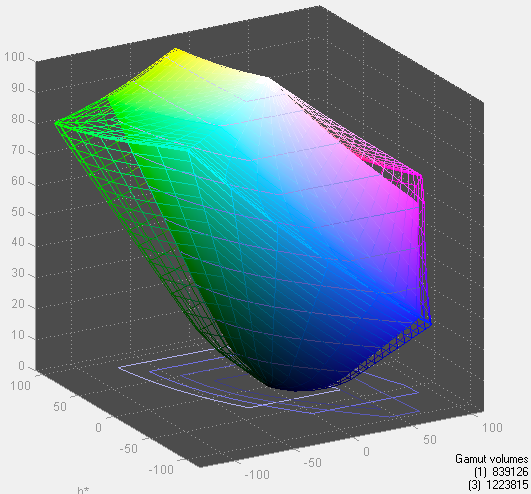
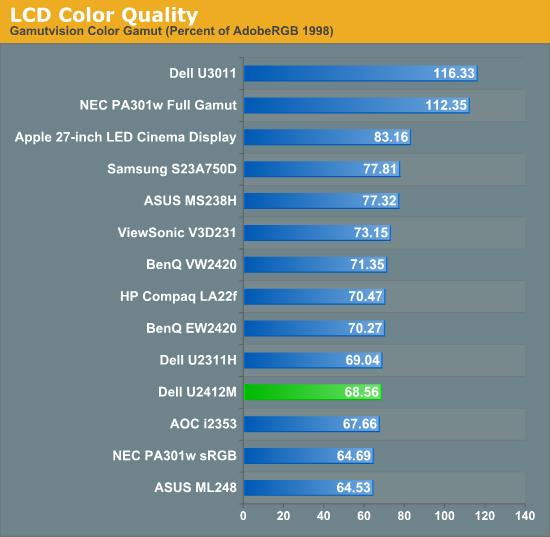
The Dell has around 70% of the AdobeRGB colorspace, which is close to the sRGB standard. We expected this as our blue dE values were so high and if we could do more than 70% of the AdobeRGB gamut we would see more accurate results there. However, I don’t think anyone considering the U2412M with it's high blue dE values will reject it because of its slightly smaller than sRGB gamut.


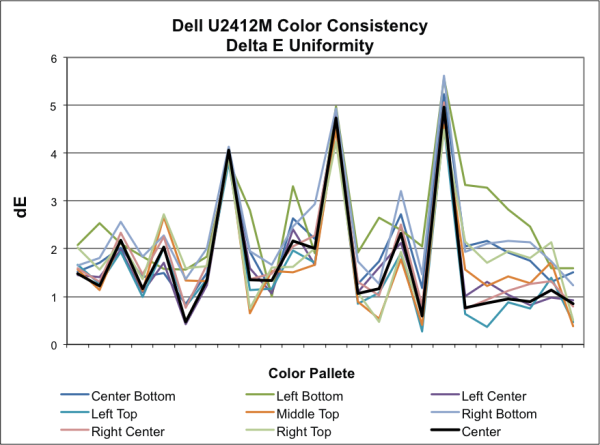
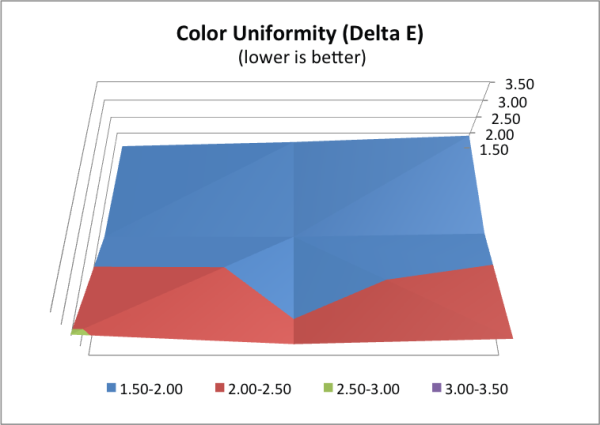








143 Comments
View All Comments
Death666Angel - Tuesday, February 28, 2012 - link
Honestly, if I had to chose between 16:9 with 1080p or 16:10 with 900p, I'd take 16:9. The real issue people argue is that the 24" market has gone 16:9 with 1080p. No gamer or other user would go with anything below 22" unless there are space constraints.piroroadkill - Wednesday, February 29, 2012 - link
The U2410 is not a budget screen by any measure, though, and although it is "old", it is not actually old. It is still being sold alongside the U2412, because the U2410 has a true 8-bit S-IPS panel, 10-bit processing, wider gamut (almost all of AdobeRGB) and a slew of inputs.It's still relevant.
seapeople - Wednesday, February 29, 2012 - link
Dude, nobody cares about your low resolution 16:10 screens.Only very strange aspect ratio freaks think 1440x900 is better than 1920x1080 anyway.
It's cool to see a budget 1920x1200 monitor out there.
Burner.Tom - Tuesday, February 28, 2012 - link
The direct competitor to reviewed Dell monitor is HP ZR2440w 24-inch LED Backlit IPS Monitor, not ZR24 - its the previous generation.PS: Dell isnt the LCD panel maker - its LG, probably model LM240WU8.
Burner.Tom - Tuesday, February 28, 2012 - link
HP ZR2440w 24-inch LED Backlit IPS Monitor - Overviewhttp://h18000.www1.hp.com/products/quickspecs/1414...
darwinosx - Tuesday, February 28, 2012 - link
The HP is a tad bit more expensive but a much better deal with much better service. I'm surprised the author didn't know this was actually the competitor for this Dell not the old HP monitor.cheinonen - Tuesday, February 28, 2012 - link
For competitors I was specifically search for other IPS/VA panels with 1920x1200 resolution that were within $75 (or 25%) of the price of the Dell. The only model that came up at the time of searching was the older HP, which is why it was listed. There are a lot of other 16:10 IPS/VA panels, but once you got past being within 25% of the price, I didn't consider them direct competitors anymore.Burner.Tom - Tuesday, February 28, 2012 - link
U2412M and ZR2440w are direct competitors from hardware point of view (LCD panel) but the price is really better in Dell case.In Slovakia, its 253€ for Dell and 350€ for HP, both have 36 months On-site warranty. The question is - why is HP so expensive? I guess there must be something cheaper used in Dell monitor (power circuit, controller board, ...). Who is OEM of the Dell? ZR24w and ZR2440w are made by Tatung.
JarredWalton - Tuesday, February 28, 2012 - link
Wait, what makes the HP a "much better deal"? I'd call service of HP and Dell monitors pretty close to equal, and the HP is $50 more for the lowest price I can find. 15% more is only "a bit more"? They're both eIPS AFAICT, so other than the nebulous "service and support" aspect, why would one be better than the other?Touche - Tuesday, February 28, 2012 - link
HP has more inputs, a scaler for 1:1, thus can be hooked up to consoles, and better RTC control. The latter makes it a bit more responsive, but former to have higher input lag. Comparing several reviews, HP tends to have better uniformity.